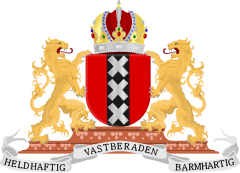Coat of arms of Amsterdam
| Coat of arms of Amsterdam | |
|---|---|
 |
|
| Versions | |

Escutcheon-only version
|
|
| Details | |
| Armiger | City of Amsterdam |
| Crest | The Imperial Crown of Austria, proper |
| Escutcheon | Gules, a pale sable charged with three saltorels argent in pale |
| Supporters | Two lions rampant proper |
| Compartment | A stone pedestal proper |
| Motto | Heldhaftig, Vastberaden, Barmhartig (Dutch: "Valiant, Steadfast, Compassionate") |
The coat of arms of Amsterdam is the official symbol of the city of Amsterdam. It consists of a red shield and a black pale with three silver Saint Andrew's Crosses, the Imperial Crown of Austria, two golden lions, and the motto of Amsterdam. Several heraldic elements have their basis in the history of Amsterdam. The crosses and the crown can be found as decorations on different locations in the city.
In the coat of arms of Amsterdam, the field of the escutcheon (heraldic shield) is red. The field is charged with three vertically ordered silver or white Saint Andrew's Crosses on top of a black pale. The field and the pale result in three vertical bands in the colours red and black.
Some people say the three saltires (X's) represent the three dangers of Old Amsterdam: fire, floods, and the Black Death. That theory however has no historical basis. The crosses probably have their origin in the shield of the noble family Persijn. The knight Jan Persijn was "lord" of Amstelledamme (Amsterdam) from 1280 to 1282. In the escutcheons of Dordrecht and Delft, two other cities in Holland, the pale refers to water. In analogy with this, the black pale in the escutcheon of Amsterdam would refer to the river Amstel. Both the colours and the crosses are also found in the escutcheons of two towns near Amsterdam: the village of Ouder-Amstel on the banks of the river Amstel to the southeast, and Nieuwer-Amstel (now the suburb Amstelveen) to the southwest. Both villages were also the property of the Persijn family.
...
Wikipedia
